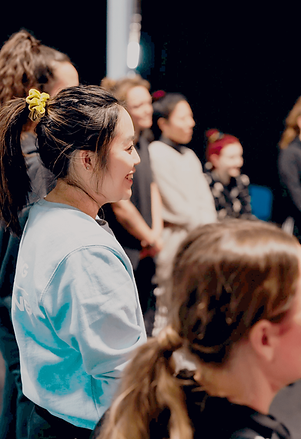Shoulder exercises: circus edition
- Bethany Shum

- Mar 6, 2024
- 4 min read
Updated: Apr 16, 2024
By Beth Shum
Background
Circus arts have been gaining popularity in recent years, and it's no surprise as to why. The art form combines athleticism, creativity, and awe-inspiring performances that leave audiences breathless. However, with any physical activity comes the risk of injury.
A recent study on circus student injury data found that shoulder injuries are a common occurrence among performers.
Shoulder injury rates
The study found that shoulder injuries accounted for 26% of all injuries sustained by circus students (Stuckey et al 2022).
These injuries can be attributed to repetitive overhead movements, such as those involved in aerial acts, as well as the weight-bearing activities common in hand-balancing and partner acrobatics.
It's important for circus students to take care of their shoulders to avoid injuries that could potentially end their careers.
Sooooo....what can I do?
To help with shoulder rehab and strengthening, here are three exercises to incorporate into your training routine!
Exercise #1: Swiss Ball Bridge With Alternate Knee Extension
Instructions:
Sit on the ball, then walk your legs out so that your head and shoulders are supported by the ball.
Place your hands on your hips.
Lift your hips towards the ceiling.
Hold this position before straightening your leg slowly, then lower. Repeat with the opposite leg. Do not let your hips or pelvis drop during the exercise.
Adaptation (Easier): Put the ball in the corner of the room.
CLINICIAN NOTES: It is important to ensure patients don’t overuse their erector spinae during this exercise - the basic start position aims to establish a balance between gluteal and back extensor muscle groups. The addition of a leg lift challenges trunk control.
(Carriere 1998) (Elphinston 2013)
Exercise #2: Swiss Ball Angel Circles
Instructions:
Sit on the ball, then walk your legs out so that your head and shoulders are supported by the ball.
Using some light weights, take your hands out to the side into an arc movement, over your head and back down to your sides again.
Adaptation (Easier): Do this without weights.
CLINICIAN NOTES: Whilst supporting the upper body on a swiss ball aims to emphasise trunk stability during elevation it does not consistently increase trunk muscle activation in all patients when compared with a stable base of support. The effect can be very variable between patients.
(Carriere 1998) (Elphinston 2013)
Exercise #3: Swimming With Weights On Swiss Ball
Instructions:
Roll over a Swiss ball positioning it under your trunk.
Steady yourself with your hands and feet.
Maintaining your balance slowly lift one leg and the opposite hand holding a small weight, then repeat on the other side.
Adaptation (Easier): To make this easier do not use the weight.
CLINICIAN NOTES: Supporting the body on a Swiss ball does not consistently increase muscle activation in patients compared with a stable base of support. The main benefits appear to be one of increasing proprioception and reducing load. You can alter the emphasis on specific scapula muscles by changing which leg is extended. Contra-lateral leg extension will bias lower trapezius activity, whereas ipsilateral leg extension will bias serratus anterior activity.
(Maenhout et al 2010) (Cools et al 2007) (De Mey et al 2013)
(Lee et al 2013) (de Oliviera et al 2008 )
Conclusion
In conclusion, shoulder injuries are a common occurrence among circus students, but with proper care and exercise, they can be avoided. Incorporating exercises such as the shoulder blade squeeze, external rotation, and overhead press into your training routine can help with shoulder rehab and strengthening.
Remember to always listen to your body and seek medical attention if you experience any pain or discomfort.
References:
Cools, A. M., Struyf, F., De Mey, K., et al. (2007). Rehabilitation of scapular dyskinesis: From the office worker to the elite overhead athlete. British Journal of Sports Medicine, 48(8), 692–69
Lee, S., Park, J., & Lee, D. (2013). The effects of cervical stabilization exercises on the electromyographic activity of shoulder stabilizers. Journal of Physical Therapy Science, 25(12), 1557–1560
De Oliveira, A. S. (2008). Activation of the shoulder and arm muscles during axial load exercises on a stable base of support and on a medicine ball. Journal of Electromyography and Kinesiology, 18(2), 235–242
De Mey, K., Struyf, F., Cools, A. M., & Cagnie, B. (2013). Kinetic chain influences on upper and lower trapezius muscle activation during eight variations of a scapular retraction exercise in overhead athletes. Journal of Science and Medicine in Sport, 16(1), 65–704
Maenhout, A., Van Praet, K., Pizzi, L., Van Herzeele, M., & Cools, A. (2010). Electromyographic analysis of knee push-up plus variations: What is the influence of the kinetic chain on scapular muscle activity? British Journal of Sports Medicine, 44(14), 1010–1015
Carrière, B. (1998). The Swiss Ball: Theory, Basic Exercises and Clinical Application. SpringerLink1
Elphinston, J. (2008). Stability, Sport, and Performance Movement: Great Technique without Injury. Lotus Publishing
Stuckey, M. I., Bruinooge, B., Aubertin, P., & Kriellaars, D. (2022). Clinical burden of injuries in students at a professional circus college: A 7.5-year longitudinal study. Medical Problems of Performing Artists, 37(2), 98-105. doi: 10.21091/mppa.2022.2015. PMID: 35637562.
Our articles are not designed to replace medical advice. If you have an injury we recommend seeing a qualified health professional. We offer both in-person assessments and online consultations.





.png)





Comments